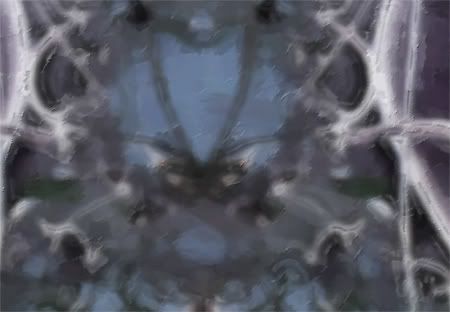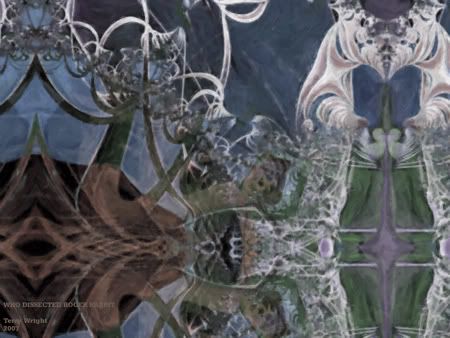Who Dissected Roger Rabbit
Who Dissected Roger Rabbit (2007)
The function of art is to disturb. Science reassures.
--Georges Braque
Andrea Yates believed that cartoon characters told her she was a bad mother who fed her children too much candy...
--Court TV News
For some reason, disembowelment and bloodshed is a helluva lot funnier when it's animated. We have no idea why. It's just the way it is.
--Atom Films
This image has, well, guts.
There's been quite a bit of talk on this blog about breaking the traditional assumptions that fractal art is grounded in an aesthetics of beauty. Fractals are abstract. So how can they "mean" anything? And, if they are non-referential, does this imply they can only be wildly pleasing to the eye? Exhibit A: Another saturated spiral explodes from its slick paper as one turns over each new month in a Fractal Universe calendar.
Still, there has also been plenty of talk here lately about "ugly" fractals. Fractals "with dirty faces." Fractals that refuse to be eye candy. Fractals that assault rather than soothe the senses.
Is my image today in bad taste? Or merely a comment on the exaggerated violence found in many cartoons. After all, a far worse fate usually awaits Tom in every Tom and Jerry short. Lawnmowers shaving him from tail to skull. A falling iron transforming the top of his head into a landing strip.
Wile E. Coyote gets today's picture -- even if Itchy and Scratchy feel it doesn't go far enough.
One of Tex Avery's whistling wolves getting smashed with a frying pan that turns his face into a dinner plate is funny. Cartoon characters whispering to Andrea Yates and telling her to drown her kids in a bathtub is not funny.
And fractals, as art, can steer viewers either way.
So is my image today disturbing? Or as funny as being pulverized into an accordion shape by a falling anvil? Or is it just silly or pretentious or bland. Whatever. You -- the viewer -- get to decide.
But I'm betting it's not pretty.

Upper left corner detail of Who Dissected Roger Rabbit
~/~
Image made with Sterling-ware and post-processed until I chased it off a cliff, waved goodbye, and disappeared downward leaving only a small cloud of smoke behind.
Rooms with a View. Please note the new address. Regular readers will know why I was forced to move.
Blog with a View





3 Comments:
I like it.
Seems curious that both your 'ugly' image & mine are reminiscent of dead animals. Presumably this is at least partly hardwired into the hominid brain: intricate geometric patterns good, decaying corpses bad.
8/07/2007 12:11 AM
Hey there,
Ok, first off, I'm a noob/FNG when it comes to fractal art (sort of). I understand the software side of it, but after reading a few blogs on the subject I am founding a suprising political side of it. However one thing that concerns me. I have always seen fractal art as either A) a random mathematical equation that makes beauty out of choas or B) Finding patterns in nature or not so straight laced settings. I think fractal art is to me proof of design even in the most chaotic.
With all that said the problem I have is with the "post-processing" of fractal art. I run a stand alone system that does nothing but spew out random fractals. I go through about 700 to 1000 a day and keep maybe 150 of them. The rest that don't appeal to the senses I throw out. However, to me, post processing a fractal to make it "better" seems like cheating or ruining the whole process/purpose of fractal art in the first place.
Call me naive but at explain why post processing is considered a part of "fractal" art?
2/14/2008 7:36 PM
Hi Chief,
Thanks for dropping by and taking the time to write.
This is a touchy topic -- dear to my heart -- and probably already argued to its saturation point.
Still, since you seem interested, here are a couple of posts in the OT archives you might find interesting on the subject of fractal post-processing:
A Dream of Post Post-Processing
The Myth of Post-Processing Bias
Take It to the Limitations
Hope these are useful...
2/16/2008 3:06 PM
Post a Comment
<< Home